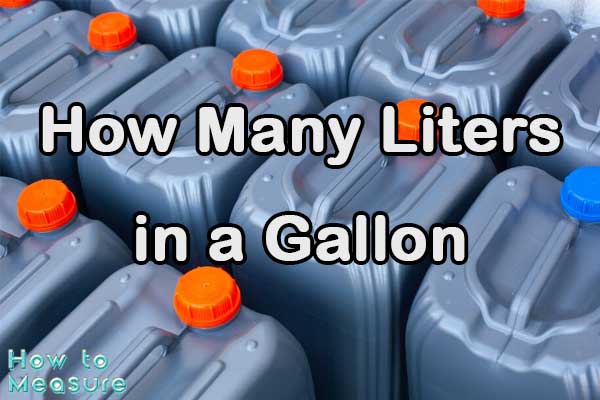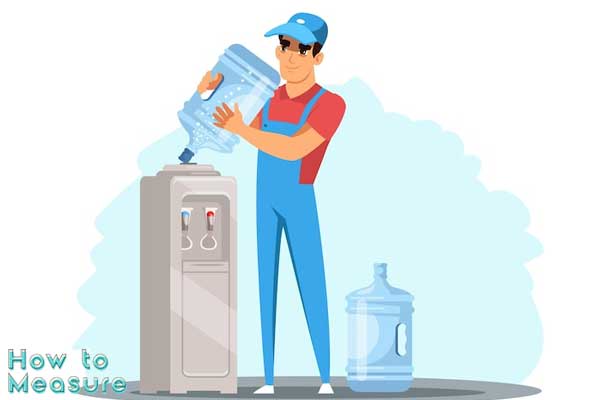Are you wondering about the conversion between liters and gallons? Whether planning a trip abroad or simply trying to understand different measurement systems, knowing how many liters are in a gallon can be useful. In this article, we will explore the conversion factor between these two units of measurement and provide a simple guide to help you make accurate conversions. So, let’s dive in!
In today’s interconnected world, it is not uncommon to encounter different measurement systems. The gallon and the liter are widely used units for measuring liquid volume but belong to different measurement systems. The gallon is commonly used in the United States, while the liter is the preferred unit in most countries adopting the metric system. Understanding the conversion between these two units can save you from confusion and ensure accurate measurements. Before we delve into the conversion process, let’s clearly understand what liters and gallons represent.
What is a Liter?
A liter is a unit of measurement used to quantify volume in the metric system. It is denoted by the symbol “L” and is widely used worldwide, particularly in countries adopting the metric system.
The liter is the volume occupied by a cube with sides measuring 10 centimeters (or 1 decimeter) in length. This cube is often referred to as a “decimeter cube.” The liter equals 1,000 cubic centimeters (cm³) or 1 cubic decimeter (dm³).
A liter is slightly larger than a quart in the US customary system. Specifically, one liter is approximately 1.0567 quarts.
The liter is a versatile unit commonly used for measuring liquid volumes in everyday life. It is often used to describe the capacity of containers, such as bottles, jugs, and tanks. For example, purchasing a beverage in a 1-liter bottle means that the bottle can hold 1 liter of liquid.
Moreover, the liter is frequently employed in scientific and technical fields for precise volume measurements. It is used in chemistry, biology, pharmacy, and various industries where accurate liquid measurements are essential.
The ease of conversion within the metric system is one of the advantages of using liters. For instance, 1 liter equals 1,000 milliliters (mL) or 0.001 cubic meters (m³). This simple decimal relationship allows for convenient conversions between different metric volume units.
In summary, a liter is a volume measurement unit in the metric system. It is widely used worldwide and offers a straightforward means of quantifying liquid volumes, making it a valuable unit in everyday life and various fields of study.
What is a Gallon?
A gallon is a unit of measurement commonly used to quantify volume, particularly in the United States and a few other countries. It is denoted by the symbol “gal.”
The gallon has different values depending on the measurement system in use. The two main systems defining the gallon are the US customary and imperial systems.
In the US customary system, one gallon equals approximately 3.78541 liters. This system is predominantly used in the United States for various applications, including measuring liquid volumes for fuel, beverages, and household use.
In the imperial system, primarily used in the United Kingdom and some other countries, one gallon equals approximately 4.54609 liters. The imperial gallon is slightly larger than the US gallon.
The origins of the gallon can be traced back to medieval times when various regional gallons were in use. These varied in size, leading to inconsistencies in volume measurements. Over time, standardization efforts led to establishment of the US gallon and the imperial gallon with their respective defined volumes.
The gallon is commonly encountered in everyday life. When purchasing gasoline in the US, for example, the price is often quoted in dollars per gallon. Similarly, when buying milk or other beverages, you might find them sold in gallon containers.
The gallon is also used in agriculture, manufacturing, and construction industries. It helps determine the quantities of liquids needed for irrigation, production processes, and mixing solutions.
It’s worth noting that the gallon is primarily used to measure liquid volume. However, it can also be applied to dry goods in specific contexts. For instance, in the US, bushels of fruits and vegetables are sometimes measured in gallons.
In conclusion, a gallon is a unit of volume measurement commonly used in the United States and other countries. It represents a specific quantity of liquid or, in some cases, dry goods. The US gallon and the imperial gallon have slightly different volumes, reflecting variations in the measurement systems used in different regions.
Converting Gallons to Liters
Converting gallons to liters is a simple process that allows you to express volumes in different units of measurement. Whether you’re dealing with fuel consumption, cooking recipes, or any other situation that requires conversions between gallons and liters, understanding this conversion is valuable. Here’s a step-by-step guide on how to convert gallons to liters.
To convert gallons to liters, you need to use a conversion factor. The conversion factor for converting gallons to liters is 3.78541. This means that one gallon is equal to 3.78541 liters.
Here’s the formula for converting gallons to liters:
Liters = Gallons * 3.78541
To perform the conversion, follow these steps:
- Obtain the number of gallons you want to convert. Let’s say you have 5 gallons that you want to convert to liters.
- Multiply the number of gallons by the conversion factor. In this case, multiply 5 by 3.78541:
- Liters = 5 * 3.78541 = 18.92705 liters
Therefore, 5 gallons is equal to 18.92705 liters.
When performing the conversion, using the appropriate conversion factor for the specific gallon you are working with is essential. As mentioned earlier, there are different values for the gallon in different measurement systems, such as the US and UK gallon. Use the correct conversion factor based on the gallon system you are dealing with.
Converting gallons to liters is a useful skill in various scenarios. For example, if you’re traveling to a country that uses liters as the primary unit of volume, understanding this conversion allows you to estimate the capacity of containers or understand liquid measurements accurately.
In conclusion, converting gallons to liters involves multiplying the gallons by the conversion factor of 3.78541. This conversion lets you express volumes in liters, which is commonly used in many countries. Mastering this conversion allows you to navigate different measurement systems and ensure accurate volume calculations.
Example: Converting 5 Gallons to Liters
To convert 5 gallons to liters, we will use the conversion formula:
makefileCopy code
Liters = 5 * 3.78541 ≈ 18.92705 liters
Hence, 5 gallons is approximately equal to 18.92705 liters.
Converting Liters to Gallons
Converting liters to gallons is a straightforward process that allows you to express volumes in different units of measurement. Whether you’re dealing with fuel efficiency, cooking recipes, or any other situation that requires conversions between liters and gallons, understanding this conversion is valuable. Here’s a step-by-step guide on how to convert liters to gallons.
To convert liters to gallons, you need to use a conversion factor. The conversion factor for converting liters to gallons is approximately 0.264172. This means that one liter is approximately equal to 0.264172 gallons.
Here’s the formula for converting liters to gallons:
Gallons = Liters * 0.264172
To perform the conversion, follow these steps:
- Obtain the number of liters you want to convert. Let’s say you have 10 liters that you want to convert to gallons.
- Multiply the number of liters by the conversion factor. In this case, multiply 10 by 0.264172:
- Gallons = 10 * 0.264172 = 2.64172 gallons
Therefore, 10 liters is approximately equal to 2.64172 gallons.
When performing the conversion, it’s important to note that the result may not be an exact number of gallons due to the conversion factor’s decimal value. Therefore, it’s common to round the result to a reasonable number of decimal places based on the desired level of precision.
Converting liters to gallons is a useful skill in various practical situations. For example, if you compare fuel efficiency between countries that use different measurement systems, understanding this conversion allows you to make accurate comparisons and calculations.
Converting liters to gallons involves multiplying the number by the conversion factor of approximately 0.264172. This conversion allows you to express volumes in gallons, commonly used in many countries, including the United States. Mastering this conversion allows you to navigate different measurement systems and ensure precise volume calculations.
Example: Converting 10 Liters to Gallons
To convert 10 liters to gallons, we will use the conversion formula:
makefileCopy code
Gallons = 10 / 3.78541 ≈ 2.64172 gallons
So, 10 liters is approximately equal to 2.64172 gallons.
Common Applications of Liters and Gallons
Understanding the conversion between liters and gallons can be helpful in various real-life scenarios. Here are some common applications where knowledge of this conversion is valuable:
- Fuel Consumption: Converting between liters and gallons is essential when calculating fuel efficiency or comparing gas mileage.
- International Travel: If you’re traveling to a country that uses liters instead of gallons, knowing the conversion factor will help you understand the fuel pricing or estimate the capacity of containers.
- Cooking and Baking: Many recipes from different regions may use either liters or gallons as the unit of measurement. Converting between the two will enable you to follow recipes accurately.
The Importance of Knowing the Conversion of Liters in Gallon
Knowing the conversion between different units of measurement, such as liters and gallons, holds significant importance in various practical scenarios. Here are some reasons why understanding the conversion is valuable:
- Accurate Measurements: Knowledge of the conversion allows you to make precise volume measurements. Whether dealing with liquids in cooking recipes, fuel consumption calculations, or any other application involving volume, knowing the conversion ensures accurate results.
- International Understanding: In an increasingly interconnected world, knowing the conversion between liters and gallons facilitates communication and understanding between people from different countries. It allows for seamless discussions, comparisons, and collaborations involving liquid volumes, especially when dealing with individuals or businesses using different measurement systems.
- Cross-Cultural Competence: Understanding the conversion enhances cross-cultural competence, particularly when using different measurement systems. It demonstrates respect and adaptability when interacting with individuals from diverse backgrounds, ensuring effective communication and avoiding misunderstandings.
- Travel and International Transactions: Knowledge of the conversion between liters and gallons becomes vital when traveling or engaging in international transactions. It enables you to navigate foreign measurement systems, understand pricing, estimate container capacities, and ensure accurate quantity assessments.
- Recipe Adaptation: Many recipes come from different regions that may use liters or gallons as the unit of measurement. Converting between the two allows you to adapt and follow recipes accurately, ensuring consistent results in your cooking or baking endeavors.
- Professional Fields: Various professional fields, such as engineering, manufacturing, chemistry, and agriculture, require precise volume measurements. Understanding the conversion between liters and gallons is essential for professionals in these industries to carry out their work accurately and efficiently.
- Fluid Logistics and Management: In industries that deal with fluid logistics, such as transportation, storage, or distribution of liquids, knowing the conversion between liters and gallons is crucial. It enables effective planning, estimation of quantities, and efficient management of resources.
- Standardization and Consistency: Understanding the conversion helps establish standardization and consistency in volume measurements. It allows for uniformity in data representation, making it easier to compare and analyze information across different systems and contexts.
Knowing the conversion between liters and gallons significantly ensures accurate measurements, facilitates international understanding, adapts to different cultural contexts, and enables seamless communication in various practical situations. It enhances precision, promotes cross-cultural competence, and efficiently manages volume-related tasks in both personal and professional domains.
Why is the US gallon different from the UK gallon?
The difference between the US gallon and the UK gallon stems from the historical development of the measurement systems in each country.
The US gallon and the UK gallon belong to two different measurement systems: the US customary system and the imperial system, respectively. These systems evolved independently and have distinct definitions for their respective gallons.
The US gallon is smaller than the UK gallon. In the US customary system, one gallon equals 3.78541 liters. This value is derived from the definition that a gallon equals 231 cubic inches.
On the other hand, the UK gallon is larger than the US gallon. In the imperial system, one gallon is equal to approximately 4.54609 liters. The definition of the UK gallon is based on the volume of 10 pounds of water at a specified temperature.
The difference in the size of the gallons can be attributed to historical reasons and variations in the development of the measurement systems. Over time, the two systems have diverged, leading to different values for the gallon in each system.
It’s important to note that when converting between liters and gallons, it’s crucial to use the appropriate conversion factor depending on whether you are working with the US or UK gallon.
Conclusion
In conclusion, understanding the conversion between liters and gallons is essential for practical liquid volume applications. By knowing the conversion factors and using the simple formulas provided, you can easily convert between these two units of measurement. Whether traveling, cooking, or dealing with fuel consumption, converting liters to gallons and vice versa will enhance your accuracy and efficiency.
FAQs
Q1: Is a liter bigger than a gallon?
A1: No, a gallon is larger than a liter. In the US customary system, one gallon is approximately 3.78541 liters.
Q2: Why are there different values for a gallon?
A2: The gallon has different values in different measurement systems. The US gallon is smaller than the imperial gallon, resulting in different conversion factors.
Q3: Which countries use liters as a unit of measurement?
A3: The liter is the preferred unit for measuring liquid volume in most countries adopting the metric system, including Europe, Asia, and Latin America.
Q4: How do I convert liters to gallons in Excel?
A4: In Excel, you can use the conversion formula “=Liters/3.78541” to convert liters to gallons. Replace “Liters” with the cell reference containing the value you want to convert.
Q5: Where can I find a reliable conversion calculator for liters and gallons?
A5: You can find online conversion calculators that provide accurate and reliable conversions between liters and gallons. Search for “liters to gallons converter” or “gallons to liters converter” in your preferred search engine.












